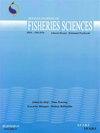研究论文:海洋褐藻Isochrysis galbana中岩藻黄质的生产及抗氧化活性的优化
IF 0.6
4区 农林科学
Q3 FISHERIES
引用次数: 8
摘要
本研究比较了在不同氮浓度下,海洋触藻Isochrysis galbana的岩藻毒素的生物量、岩藻毒素产量和抗氧化能力。在盐度试验的第一步,加尔巴纳在20‰和35‰的盐度下都能生长,但35‰的盐分是最佳的。在第二步中,在35‰的盐度下,研究了5种不同的氮浓度(N-NO3),即2、4、8、12、12 mM。藻类细胞密度随着氮浓度的增加而增加,但在氮浓度最高(12mM)的培养物中出现低生长率。在含有4mM氮(N-NO3)的培养基中培养的紫藤中,获得了72×12105“>的最大细胞密度和18.1 mg g-1的最大岩藻毒素。纯化的岩藻毒素具有很强的抗氧化性能,其中1,1-二苯基-2-丙酰肼(DPPH)的有效清除浓度为50%(EC50)自由基为0.2mg/ml。本研究表明,在35‰盐度下进行充氮培养,可以提高加尔巴藻的产量和岩藻毒素浓度。同样在这种条件下,这种微藻可以成为岩藻毒素的商业来源,用于人类健康和营养。本文章由计算机程序翻译,如有差异,请以英文原文为准。
Research Article: Optimization of production and antioxidant activity of fucoxanthin from marine haptophyte algae, Isochrysis galbana
This study compared the biomass production, fucoxanthin production and antioxidant capacity of the fucoxanthin from the marine haptophyte algae, Isochrysis galbana under different nitrogen concentrations. At first step in the salinity test, I. galbana could grow in 20‰ and 35‰ but the 35‰ salinity was optimal. At second step, five different nitrogen concentrations (N-NO3) of 2, 4, 8, 12 12 mM, at the salinity of 35‰, were investigated. Algal cell density increased as nitrogen concentrations increased, but a low growth rate occurred in the culture with the highest nitrogen concentration (12 mM). The maximum cell density of 72× 12105"> and the maximum amount of fucoxanthin (18.1 mg g-1) was obtained in I. galbana cultured in media containing four mM nitrogen (N-NO3). The purified fucoxanthin exhibited strong antioxidant properties, with the effective concentration for 50% scavenging (EC50) of 1, 1-dihpenyl-2-picrylhydrazyl (DPPH) radical, being 0.2 mg/ml. This study suggests that the production and fucoxanthin concentration of I. galbana can be improved using nitrogen-replete culture in 35‰ salinity. Also under this condition this microalgaecan be a commercial source of fucoxanthin for human health and nutrition.
求助全文
通过发布文献求助,成功后即可免费获取论文全文。
去求助
来源期刊

Iranian Journal of Fisheries Sciences
FISHERIES-
CiteScore
2.30
自引率
11.10%
发文量
0
审稿时长
3 months
期刊介绍:
1- Living various species (contains animals and vegetal species) in various aquatic ecosystems.
2- Health and diseases of aquatic species.
3- Determining the stocks and specific time and location for catching and reliable exploitation for sustainable development.
4- Methods of propagation and culture of high value aquatic resources.
5- Aquatic stock assessment and the methods of restocking the high value species and suggestion for rate, areas and the time for releasing fish and other aquatic organisms fries.
6- Pollutant agents and their effects to the environments of aquatic species.
7- Feed and feeding in aquatic organisms.
8- Fish processing and producing new products.
9- The economic and social aspects of fisheries.
 求助内容:
求助内容: 应助结果提醒方式:
应助结果提醒方式:


